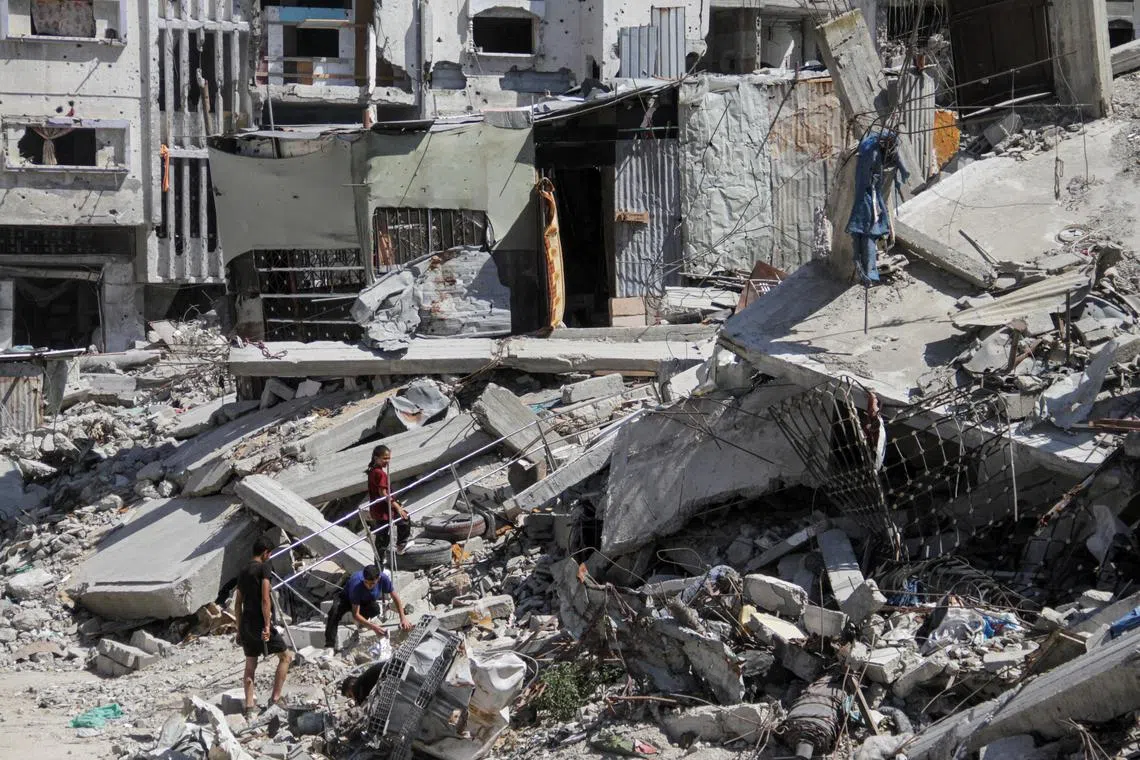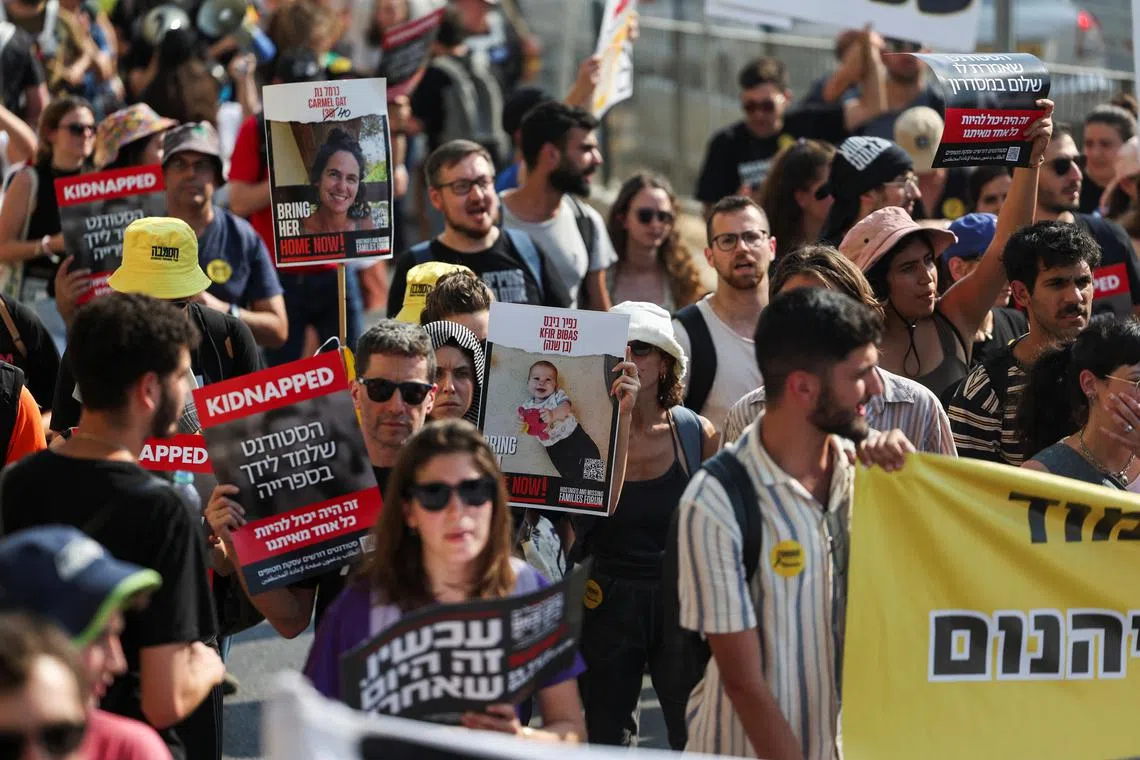Israel hits Gaza as tensions surge on Lebanon border
Sign up now: Get ST's newsletters delivered to your inbox

Palestinians walking among damaged buildings which were destroyed during Israel’s military offensive, in the Gaza Strip, on June 12.
PHOTO: REUTERS
Follow topic:
GAZA STRIP - Israeli strikes hit Gaza on June 14 as truce talks with Hamas militants failed to progress and tensions surged on Israel’s northern border with Lebanon.
Witnesses reported the strikes in various parts of the Gaza Strip in the morning, particularly the centre.
At Al-Aqsa Martyrs Hospital in the central city of Deir al-Balah, men gathered over the body of an 11-year-old boy who died during bombardment of the nearby Bureij refugee camp.
Clad in a black singlet, the child lay on a floor smeared with fresh blood, a white bandage covering the top half of his face, AFP images showed.
Israel’s military on June 14 said troops continued operations in central Gaza, where warplanes had struck a militant cell and “military structure” in the Zeitun area.
After projectiles were fired at night from northern Gaza into southern Israel on June 13, artillery and aircraft hit the launch sites, the army said.
The war began after Hamas’ unprecedented Oct 7 attack on southern Israel,
The militants also seized 251 hostages. Of these, 116 remain in Gaza, although the army says 41 are dead.
Israel’s retaliatory military offensive has left at least 37,266 people dead in Gaza, also mostly civilians, according to the Health Ministry in the Hamas-ruled territory.
Fears of a broader Middle East conflict have surged again, with Lebanon-based Hezbollah fighters, who are backed by Iran, launching waves of rockets against Israeli military targets on June 12 and 13.
Hezbollah said the strikes were retaliation for the Israeli killing of one of its commanders.
Sirens sounded on the morning of June 14 in northern Israel, where police said munitions had fallen in the Kiryat Shmona area, with no immediate sign of victims.
Since the Gaza war began, Hezbollah and Israeli forces have exchanged near-daily cross-border fire, which has escalated.
June 13’s major attack involved rockets and “squadrons of explosive-laden drones”, Hezbollah said.
The Israeli army said about 40 projectiles were launched, with most intercepted, though some caused fires.
An Israeli government spokesman vowed to “respond with force to all aggressions by Hezbollah”.
Later, Lebanon’s National News Agency reported that Israeli “warplanes launched a raid targeting a house” in the town of Janata in Lebanon’s south.
Two women were killed, village official Hassan Shur said.
French President Emmanuel Macron said on June 13 that his country, the US and Israel would work together to ease tensions in the area.
“We will do the same with the Lebanese authorities,” he added, speaking at a summit of the Group of Seven (G-7) democratic group of countries.
During a Middle East trip this week to push a Gaza ceasefire proposal,
At the G-7 summit in Italy, US President Joe Biden called Hamas “the biggest hang-up so far” to reaching a deal on a Gaza truce and hostage release.
Mr Blinken has said Israel backs the plan, but Israeli Prime Minister Benjamin Netanyahu, whose far-right government allies are strongly opposed, has not publicly endorsed it.
In Jerusalem on June 13, a student-led protest near Israel’s Parliament urged the government to secure an agreement to bring the remaining hostages home.
“Ceasefire now,” read one banner.
Similar demonstrations have regularly occurred in Tel Aviv.
Mr Biden’s road map for the first truce since a week-long pause and hostage-prisoner release in November includes a six-week ceasefire, an exchange of hostages for Palestinian prisoners, and Gaza’s reconstruction.
On June 10, the United Nations Security Council adopted a US-drafted resolution supporting the plan.

People taking part in a protest demanding the immediate release of hostages in Jerusalem on June 13.
PHOTO: REUTERS
The World Health Organisation said more than 8,000 children aged under five in Gaza had been treated for acute malnutrition.
AFP images from Al-Aqsa Martyrs Hospital showed the grieving family of a 10-year-old boy who died suffering from malnutrition. His limbs appeared thin and his ribcage was clearly visible.
As Muslims worldwide prepare to mark Eid al-Adha, starting on June 16, Gazans lamented soaring prices and shortages of essential goods – including sacrificial animals for the festival – leaving little to celebrate in the besieged territory.
“There is no Eid spirit,” Mr Mohammed Shabat, who – like most of Gaza’s population – has been displaced by the war, said outside his tent in Deir al-Balah.
In the Israeli-occupied West Bank, Palestinian officials said an Israeli military raid killed three people in the town of Qabatiya on June 13. Israel’s military reported it had “eliminated two wanted suspects”.
The US on June 14 condemned the Israeli finance minister’s “wrong-headed” decision to redirect US$35 million (S$47 million) in tax revenue collected on behalf of the Palestinian Authority (PA) to families of “victims of terrorism”.
Economists have previously said Israel is withholding tax revenue it collects on the PA’s behalf. In May, the World Bank said the PA’s fiscal situation had worsened, putting it at risk of financial collapse.
The fallout from the Gaza war also escalated this week off Yemen.
Two cruise missiles launched by Yemen’s Iran-backed Houthi rebels struck a bulk cargo carrier in the Gulf of Aden on June 13, severely injuring a sailor who was evacuated by American forces, the US military said.
The Houthis said they had carried out attacks on three ships within 24 hours, including against the bulk carrier.
They are the Houthis’ latest strikes on shipping in the area’s waterways, vital to world trade, in what they say are acts of solidarity with the Palestinians. AFP

